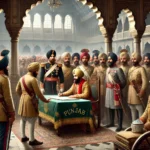PAK YATRA is a tour operator company providing tour services and facilitates Sikh community from different parts of the world.
History of Moti Masjid
Background:
Moti Masjid, also known as the Pearl Mosque, is a 17th-century religious building located within the Lahore Fort complex in Lahore, Punjab, Pakistan. Built during the Mughal era, it is a testament to the architectural prowess and religious significance of the time.
Historical Evolution:
The construction of Moti Masjid is attributed to Mughal Emperor Jahangir, although significant modifications were made by his successor, Shah Jahan. Built between 1630 and 1635, it is one of the first among the “pearl” named mosques, with others built by Shah Jahan in Agra Fort and his son Aurangzeb in the Red Fort.
Importance of the Place:
Moti Masjid holds immense importance as a religious site and architectural marvel. Its significance lies in its historical association with the Mughal Empire, as well as its role as a place of worship and spiritual devotion for visitors and devotees.
Story Behind:
Originally intended as a private prayer area for the imperial harem, Moti Masjid served as a place of worship for the royal household. Over the centuries, it has witnessed transitions in rulership, from the Mughals to the Sikhs and later the British, each leaving their mark on the structure.
Location:
Situated on the western side of Lahore Fort, near the Alamgiri Gate, Moti Masjid is strategically positioned within the fort complex. Its location enhances its prominence and accessibility for visitors exploring the historical site.
Latitude and Longitude:
Geographic coordinates: 31°35′18″N 74°18′50″E / 31.58847°N 74.313787°E
Preservation Efforts:
Throughout its history, Moti Masjid has undergone periods of preservation and restoration. In 1899, on the orders of Lord Curzon, the mosque was restored to its former status after being used as a state treasury during the Sikh and British eras. Preservation efforts continue to ensure the longevity of this architectural gem.
Architectural Marvel:
Built entirely of white marble brought from Makrana, India, Moti Masjid showcases exquisite Mughal architecture. The facade features cusped arches, engaged baluster columns, and intricate detailing, typical of Shah Jahan’s era. Its interior, adorned with decorative ceilings and domes, reflects the grandeur of Mughal design.
Historical Significance:
Moti Masjid stands as a symbol of religious tolerance and cultural heritage, representing the rich history of the Mughal Empire in the region. Its transformation from a private prayer area to a revered mosque and later a treasury highlights its adaptive significance through changing times. In conclusion, Moti Masjid remains a timeless testament to the Mughal era’s architectural brilliance and religious devotion, inviting visitors to explore its historical significance and marvel at its enduring beauty.




